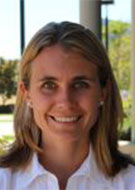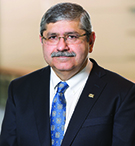RSNA R&E Research Paves the Way to Clinical Practice
R&E Foundation awards $5 million in grants to researchers in 2019



Over the past 35 years, R&E Foundation grants have enabled many investigators to take medical imaging research and technical innovation from conception to clinical practice. Two examples are R&E Foundation grant recipients Erin Gillespie, MD, and Susie Huang, MD, PhD.
As a radiation oncology resident in 2016, Dr. Gillespie identified a need to make image-based contouring guidelines more accessible for trainees and providers involved in radiation therapy treatment planning.
Through a 2016 RSNA Research Resident Grant, Dr. Gillespie developed an online reference tool with interactive 3D images and evidence-based contouring guidelines on the website eContour.org. In less than three years, the site has gained more than 13,000 registered users from 128 countries, including about half of the radiation oncologists in the U.S.
In 2007, Dr. Huang received her first RSNA award, the RSNA Research Medical Student Grant which she used to investigate whether the nonlinear spin interactions she studied as a doctoral student could improve the contrast and sensitivity of MRI acquisition. She continued her research through a 2014 Philips Healthcare/RSNA Research Resident Grant and a National Institutes of Health (NIH) grant and is now working to develop the next-generation MR scanner for brain connectivity and to translate new fast MR sequences into clinical practice.
Such innovative research is the foundation of the R&E grant program, said Umar Mahmood, MD, PhD, a member of the R&E Foundation Board of the Trustees and RSNA Board of Directors.
“Innovations that routinely improve patient care were once just a researcher’s idea,” said Dr. Mahmood, vice chair of the Precision Imaging Department of Radiology, Massachusetts General Hospital (MGH) and professor of radiology, Harvard Medical School. “R&E grants and awards are the rocket fuel to get new technologies into clinical practice faster.”
Drs. Gillespie and Huang are just two of the 1,500 researchers who have received funding from the R&E Foundation since 1984. In 2019, the Foundation will again dedicate $5 million to 10 different types of grants and awards through the support of individuals, private practices and corporations.
“Radiology wouldn’t be what it is today with the R&E Foundation,” Dr. Mahmood said. “Every dollar awarded by the Foundation results in $50 in additional funding. Our $65 million in R&E funding awarded since 1984 equates to a $3 billion impact on medical imaging.”
R&E Grants Lead to NIH Funding
Dr. Huang had just completed a doctorate in physical chemistry and was working at the Martino Center for Biomedical Imaging at MGH as a medical student when she was awarded her first R&E grant.
“The medical student grant really jump-started the project and enabled me to do key experiments demonstrating that one of the spin interactions I studied as a doctoral student could be used to accelerate MRI acquisition,” said Dr. Huang, now an assistant professor at Harvard Medical School neuroradiologist at MGH.
Through her 2014 RSNA Research Resident Grant, she studied axonal damage in multiple sclerosis with the MGH Connectome MR scanner, which is eight times more powerful than conventional MRI machines.
“The RSNA Research Resident Grant provided me with critical protected research time to develop pilot data and secure an NIH Career Development Award,” she said.
Dr. Huang has subsequently secured a $14 million NIH Brain Research through Advancing Innovative Neurotechnologies (BRAIN) U01 grant to develop the next-generation connectome MRI scanner for multi-scale mapping of the brain.
This research underscores the importance of collaboration with industry and practicing radiologists to advance medical imaging technology.
“Academic-industrial partnerships have proven time and again to accelerate the development and translation of cutting-edge imaging technologies,” Dr. Huang said.
R&E Grants Fund Ongoing Contouring Research
After developing a novel interactive contouring atlas for radiation oncology through her first R&E grant, Dr. Gillespie used her 2017 RSNA Education Scholar Grant to develop an online contouring simulation tool for radiation oncology providers.This work has provided preliminary data for a larger grant that is under final review at the Agency for Healthcare Research and Quality.
A third grant from the R&E Foundation, a 2019 Education Innovation Grant, will allow Dr. Gillespie to incorporate eContour into the International Journal of Radiation Oncology Biology Physics, as well as the most widely used clinical pathways product among radiation oncologists.
“RSNA is an organization that wants to foster research projects and take them to the next level,” she said. “This project speaks to the core of the R&E Foundation and its support of research and development for tools that improve the quality of clinical care.”
For more information about available grants or to make a donation to the RSNA R&E Foundation, visit RSNA.org/Foundation.
Pre-Applications Due Aug. 30 for R&E Foundation 2020 Education Grants
The pre-application deadline for the RSNA R&E Foundation 2020 Education Innovation Grant and the 2020 Education Development Grant is Aug. 30. These grants are designed to facilitate the development of educational products and content that will have a long-lasting impact on radiology education. Multi-year grants of up to $525,000 are available.
Contact Keshia Osley, assistant director, grant administration, at kosley@rsna.org or 630-571-7816, for additional information.